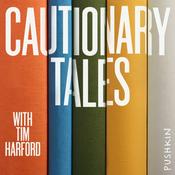Épisodes disponibles
5 sur 315
- Finland: Matti Haapoja and the Great Famine MurdersEpisode 10 of 15 | Series 36: Serial Killers in HistoryFinland's first documented serial killer terrorized two continents across three decades. This episode traces Matti Haapoja's brutal journey from famine-ravaged Finland to Siberian exile and back—a life defined by escape, violence, and ultimately, one final act of defiance.Victim HumanizationHeikki Impponen was forty-two years old when he walked along that frozen road in December 1867. A farmer with a wife named Kaisa and three children waiting at home, he had known young Matti since childhood—their fathers had worked neighboring fields, they had been boys together in the harsh Finnish countryside. He carried what little money he had, perhaps hoping to buy food during Finland's devastating Great Famine. Maria Jemina Salo was in her early twenties, trying to survive in Helsinki's rougher districts, wearing a silver necklace her mother had given her. Guard Juho Rosted had worked at Kakola Prison for eleven years, with a pregnant wife expecting their fourth child—a daughter who would never know her father.Why This Case MattersMatti Haapoja's crimes fundamentally reshaped Finland's approach to criminal justice and prison security. His four successful escapes from Kakola Prison exposed critical weaknesses in the nation's penal system, earning the facility the mocking nickname "Pakola"—the escape prison. His case prompted a complete overhaul of prison architecture and security protocols throughout Finland. The investigation techniques developed to track him helped establish the framework for modern Finnish police procedures, while the case demonstrated how the Great Famine of 1866-1868, which killed 270,000 Finns, created conditions where desperate violence flourished.Content WarningThis episode contains descriptions of violent murders and suicide. Listener discretion advised.Key Case DetailsHaapoja's criminal career spanned three decades across two continents, leaving eight confirmed victims dead and exposing the limitations of 19th-century criminal justice systems across Finland and Siberia.• Timeline: First murder December 6, 1867, during Finland's Great Famine; sentenced to Siberian exile in 1880; returned to Finland September 1890; final escape attempt October 10, 1894; death by suicide January 8, 1895• Investigation: Haapoja's escapes revealed major security flaws in Finnish prisons; his capture after Maria Salo's murder came when his notorious reputation led to his recognition in Porvoo just days after the crime• Resolution: Sentenced to death in 1891 (automatically commuted to life imprisonment as Finland had abolished capital punishment in 1826); died by his own hand while awaiting trial for murdering Guard Juho Rosted• Historical Context: The puukkojunkkari (knife-fighter) culture of Southern Ostrobothnia shaped Haapoja's violent identity; his skeleton was displayed in the Finnish Museum of Crime for 99 years before burial in 1995Historical Context & SourcesThis episode draws on records from the National Museum of Finland, the National Biography of Finland, and the BiographySampo database. Prison museum collections preserve the tools of Haapoja's escapes—rope, wooden slats, and a floorboard with a drilled hole. Contemporary newspaper accounts from the 1890s, which sensationally compared his crimes to Jack the Ripper's London murders, provide crucial details about his final trial and death. The Circuit Court records of Hausjärvi from 1891 document his arrogant confession and the commutation of his death sentence.Resources & Further ReadingFor listeners interested in exploring this case and era further, these historically significant sources provide additional context:• The National Museum of Finland maintains archival materials on 19th-century Finnish criminal justice and the puukkojunkkari phenomenon• The Finnish National Biography database (Biografiakeskus) contains verified biographical details on Haapoja and his contemporaries• Academic research on the Great Famine of 1866-1868 illuminates the devastating conditions that shaped Haapoja's early crimesCall-to-ActionNext week on Foul Play: Francisco Guerrero Pérez terrorized Mexico City for decades, targeting women the newspapers refused to mourn. Subscribe now to follow Season 36: Serial Killers in History to its conclusion.Support this podcast at — https://redcircle.com/foul-play-crime-series/donationsAdvertising Inquiries: https://redcircle.com/brandsPrivacy & Opt-Out: https://redcircle.com/privacy--------31:19
- Geneva: The Nurse Who Poisoned Her PatientsOn a warm June afternoon in 1868, a 24-year-old woman accepted a glass of lemonade from her nurse at a Geneva boarding house. Within moments, her pupils dilated grotesquely, her heart pounded violently, and reality dissolved into nightmare. That glass of lemonade broke open one of Switzerland's most disturbing criminal cases.SEASON & EPISODE CONTEXTThis is Episode 9 of Foul Play Season 36: "Serial Killers in History," examining murderers from ancient times through the early 1900s. This season explores 15 cases spanning centuries and continents, revealing how serial murder predates modern criminology by millennia.THE CASE SUMMARYBetween 1865 and 1868, Marie Jeanneret worked as a private nurse in Geneva and surrounding areas of Switzerland, moving between respectable boarding houses and private hospitals. Everywhere she went, patients died under mysterious circumstances. Eleven-year-old children. Elderly widows. Entire families.Her method was both calculated and cruel. She used cutting-edge poisons for the 1860s—plant alkaloids like atropine from belladonna and morphine from opium poppies. These substances were so difficult to detect in corpses that she might never have been caught. She offered candy she called "princesses" to children. She served sweetened water to friends. She predicted deaths days before they happened—not because she had medical insight, but because she knew exactly when the poison would finish its work.When authorities finally exhumed the bodies in 1868, they found chemical signatures of murder in decomposing tissue. The trial revealed at least six confirmed murders and perhaps thirty attempted murders. But the verdict the jury reached would create one of criminal history's most profound paradoxes—her case helped abolish the death penalty in Geneva three years later.THE VICTIMSMarie Jeanneret's victims weren't random—they were people who trusted her completely during their most vulnerable moments:Marie Grétillat, 61, hired Jeanneret for what should have been a minor illness. She died in February 1867 after weeks of escalating agony.Sophie Juvet, 58, died in September 1867 at the Maison de Santé hospital where Jeanneret worked as a nurse.Jenny-Julie Juvet, Sophie's daughter, was only 11 years old. She loved candy and trusted the nurse who brought her special bonbons called "princesses." Before she died in January 1868, she begged her family not to let the nurse near her anymore. They thought she was delirious. She wasn't—she knew.Auguste Perrod (around 80), Louise-Marie Lenoir (72), Madame Hahn, Demoiselle Gay, Demoiselle Junod, Julie Bouvier, and Jacques Gros (Julie's father) all died under Jeanneret's care between 1867 and 1868.KEY CASE DETAILSTHE METHOD: Jeanneret used belladonna (deadly nightshade) and morphine as her primary weapons. Belladonna poisoning produces distinctive symptoms: grotesquely dilated pupils, rapid heartbeat, extreme light sensitivity, terrifying hallucinations, and eventually seizures and respiratory failure. Morphine suppresses breathing until victims simply stop inhaling—the death looks peaceful but is actually suffocation.As a nurse, she had legitimate access to these substances and professional cover for every action. She mixed poisons into sweet items—lemonade, sweetened water, candy—because sugar masks the bitter taste effectively. For some victims, she administered lower doses over time, creating slow declines that mimicked natural illness. For others, she used massive doses intended to kill quickly.THE BREAKTHROUGH: The case broke open when Marie-Catherine Fritzgès, 24, survived a belladonna poisoning in June 1868. Her doctor recognized the symptoms immediately and contacted authorities. Police searched Jeanneret's rooms and found bottles of belladonna extract, containers of morphine, and detailed nursing notes documenting every symptom, decline, and death—inadvertently documenting her own crimes.HISTORICAL CONTEXT & SOURCESThe 1860s represented a turning point in forensic medicine. Swiss medical examiners used groundbreaking techniques to test tissue samples for alkaloid compounds in exhumed bodies—finding chemical signatures consistent with belladonna and morphine poisoning. This case marked one of the first instances where forensic medicine played a crucial role in securing a conviction in Switzerland.The trial opened in Geneva in late 1868 with overwhelming evidence: poisoned bodies, survivors' testimony, bottles of poison, and Jeanneret's own nursing notes. On November 19, 1868, the jury returned a stunning verdict—guilty on all counts, but they recommended clemency. Instead of execution, Jeanneret received life imprisonment with hard labor.Three years later, in 1871, the Canton of Geneva abolished the death penalty. Jeanneret's case was cited as a key example—a jury had looked at overwhelming evidence of serial murder and chosen mercy over execution.RESOURCES & FURTHER READINGSwiss criminal history archives maintain extensive records of the Jeanneret case, including original trial transcripts and forensic reports that revolutionized poison detection methods. The case remains a standard reference in medical ethics courses throughout Europe, illustrating the catastrophic consequences of betrayed medical trust.The Geneva State Archives houses original court documents from the 1868 trial. Swiss forensic medicine institutes continue to study the case as a landmark example of early toxicology and the systematic safeguards developed in response to healthcare serial killers.RELATED FOUL PLAY EPISODESIf you found this episode compelling, explore other Foul Play cases involving Victorian-era poisoners and medical professionals who betrayed their sacred trust. Season 36 examines serial killers throughout history, from ancient Rome through the early 1900s, revealing how murder predates modern criminology and how society responded to unimaginable crimes.Each episode of Foul Play combines meticulous historical research with victim-centered storytelling, honoring those whose lives were taken while examining the criminals who took them.THE LEGACYMarie Jeanneret's crimes fundamentally transformed Switzerland's approach to medical safety and criminal investigation. The case exposed critical gaps in poison control, leading to strict measures including detailed record-keeping of sales and mandatory identification checks. Background checks for medical staff became more thorough, references were more carefully vetted, and supervision was enhanced throughout Europe.Perhaps most significantly, Jeanneret's case transformed public consciousness about the nature of evil. The idea that a healthcare professional could systematically murder patients while maintaining an appearance of respectability forced society to confront uncomfortable truths. The poisoner who took at least six lives became part of the movement that saved countless others from execution—the most paradoxical legacy imaginable.ABOUT FOUL PLAYFoul Play examines history's most compelling true crime cases with meticulous research and sophisticated storytelling. Hosts Shane Waters and Wendy Cee explore serial killers from ancient Rome through the early 1900s, focusing on victim-centered narratives that honor the dead rather than sensationalizing killers. Each episode combines atmospheric period detail with rigorous historical accuracy, transporting listeners to crimes that shaped criminal justice systems across centuries and continents.CONNECT WITH FOUL PLAYNew episodes release every Tuesday at 5:00 AM EST. Follow Foul Play on social media for behind-the-scenes research, historical context, and episode updates. Visit our website for complete episode archives, source lists, and additional resources about the cases we cover.CONTENT WARNINGThis episode contains detailed descriptions of poisoning, murder of children, and medical betrayal. Listener discretion is advised. If you or someone you know needs support, resources are available through crisis helplines and mental health services.Support this podcast at — https://redcircle.com/foul-play-crime-series/donationsAdvertising Inquiries: https://redcircle.com/brandsPrivacy & Opt-Out: https://redcircle.com/privacy--------30:30
- Philippines: The Priest Who Murdered 57 ParishionersIn 1826, fellow priests caring for an ailing Father Juan Severino Mallari made a horrifying discovery in his residence: bloodstained clothing belonging to dozens of missing parishioners. Over the next ten years, investigators would uncover fifty-seven murders committed by the parish priest of Magalang, Pampanga—a man who believed killing his congregants would break a curse afflicting his mother. Father Mallari's victims trusted him completely. They came to him for confession, for blessings, for spiritual guidance. And then they disappeared. What makes this case even more tragic is that Spanish colonial authorities meticulously documented Mallari's education and artwork, but never bothered to record a single name of the fifty-seven Filipinos he murdered. This is the story of colonial erasure, untreated mental illness, and a murderous priest.This is Episode 7 of Season 36: Serial Killers in History, our ambitious exploration of forgotten murderers from ancient Rome through the early 20th century. This season examines how social inequality, colonial systems, and institutional failures enabled killers across continents and centuries. Juan Severino Mallari's case reveals the devastating intersection of Spanish colonial racism, primitive mental healthcare, and religious authority in early 19th-century Philippines. The next episode continues our journey through history's darkest moments with another case of power, isolation, and the victims erased from official records.Historical Context & BackgroundJuan Severino Mallari was born in 1785 in San Nicolas, Pampanga, into a respected Kapampangan family with church benefactor status. He earned his philosophy degree around 1800, his theology degree in 1805 at San Carlos Seminary, and was ordained at the University of Santo Tomas in 1809 by Archbishop Juan Antonio Zulaybar. But being a Filipino priest in Spanish colonial Philippines meant systemic discrimination. From 1809 to 1812, Mallari served as coadjutor in multiple parishes, applying repeatedly for parish priest positions in Orani, Mariveles, Lubao, and as chaplain at the Port of Cavite. Spanish authorities rejected him every time—not for lack of qualifications, but due to colonial racism that viewed Filipino secular priests as inferior to Spanish friars. Finally, in 1812, he became parish priest of San Bartolome Parish in Magalang, the first Filipino to hold that position in all of Pampanga. In that isolated agricultural community, trusted completely by his parishioners, Father Mallari would commit fifty-seven murders over the next decade.The Descent into MadnessAround 1816, four years after becoming parish priest, Mallari's mother fell gravely ill. He became convinced she was cursed—a belief that merged Catholic faith with pre-colonial Filipino traditions about mangkukulam (witches) who could cast deadly kulam (curses). Historical accounts describe Mallari experiencing severe hallucinations during Mass, stopping mid-sermon to converse with invisible figures. Spain had pioneered psychiatric treatment in Europe, and the Hospicio de San Jose psychiatric facility in Manila had been operational since 1811. But Mallari was in rural Pampanga, miles from Manila, and he was the parish priest—the highest religious authority in Magalang. No one recognized his psychotic delusions as treatable illness requiring intervention. When Mallari decided that killing the people he believed were witches would cure his mother, no one stopped him. His first victim likely came to confession in 1816. We don't know this person's name, age, or family situation—Spanish colonial records didn't consider such details worth documenting.The Ten-Year Killing SpreeOver the next decade, Father Mallari murdered fifty-seven of his parishioners. He killed in the privacy of the parish house—people who came for spiritual guidance, to arrange marriages, to request baptisms. After each murder, he carefully folded the victim's bloodstained clothing and preserved it in his residence. This level of organization existing alongside complete psychotic delusion reveals the terrifying complexity of his mental state. His mother died December 4, 1825. The killings hadn't saved her. Everything had been for nothing. But Mallari didn't stop because of his mother's death—he stopped because sixteen days later, several families finally gathered courage to file a formal complaint with the gobernadorcillo (town mayor). Imagine the bravery required: Filipino families in 1825 Spanish colonial Philippines accusing the parish priest—the most powerful religious figure in their town. In February 1826, when Mallari fell ill and fellow priests came to care for him, they discovered the horrifying evidence: bloodstained belongings of dozens of missing parishioners, folded and stored in his residence. Word reached the constabulary. Townspeople gathered with torches. Ten years of disappearances converged on that moment.Investigation, Trial & ExecutionWhen Spanish authorities arrested Mallari in 1826, he confessed immediately—not with remorse, but with explanation. He detailed his mother's curse, identifying fifty-seven witches, explaining why their deaths would break the curse. The trial began later that year, drawing unprecedented attention across Spanish colonial territory. Prosecutors methodically presented bloodstained clothing, stolen items from victims' families, witness testimony about Mallari's erratic behavior during Mass. The defense attempted to portray him as a respected leader framed by jealous rivals, but couldn't explain the overwhelming physical evidence or Mallari's own detailed confession. He was convicted, but not executed immediately. Mallari spent fourteen years imprisoned—fourteen years between his 1826 arrest and his 1840 execution. The colonial legal system required multiple levels of review for an unprecedented case: a Filipino priest convicted of fifty-seven murders. Those victim families waited fourteen years for justice. Finally, in 1840, Juan Severino Mallari was hanged at Bagumbayan field (today Luneta Park in Manila). He was fifty-five years old, the first Filipino priest ever executed by Spanish colonial authorities. Thirty-two years later, three more Filipino priests—the GOMBURZA martyrs—would be executed for allegedly inspiring revolt, helping spark the Philippine Revolution.The Unnamed Fifty-SevenFather Juan Severino Mallari's life is extensively recorded. Spanish colonial documents detail his birth in San Nicolas, his family's church benefactor status, his philosophy degree (circa 1800), theology degree (1805), ordination (1809), every parish appointment, every rejected job application. Examples of his calligraphy—ornate ecclesiastical documents—survive in historical archives. The Spanish system found Mallari worth documenting in extraordinary detail. The fifty-seven Filipinos he murdered? Not one name recorded. Not one age. Not one occupation. Not one family detail. Were they farmers? Merchants? Young? Old? Parents leaving behind children? We don't know. Spanish authorities didn't care. This isn't accident—it's colonial violence manifesting as bureaucratic erasure. The Spanish system existed to extract wealth and maintain control. Individual Filipino lives didn't serve Spanish interests, so they weren't recorded. Somewhere in Pampanga, descendants of those fifty-seven victims exist. People who grew up hearing family stories about a great-great-grandparent who vanished mysteriously in the 1820s, inheriting trauma without closure. Those descendants deserve to know their family member's death mattered, that their ancestor's life had value, that we haven't forgotten them even if we can't name them.Resources & Further ReadingThe National Archives of the Philippines in Manila maintain limited records from Spanish colonial Pampanga, though documentation of crimes against Filipino civilians remains incomplete. The University of Santo Tomas archives preserve ecclesiastical records from the period, including ordination documentation for Filipino priests like Mallari. Historical studies of Spanish colonial mental healthcare reveal the stark disparity between psychiatric facilities available in Manila (like the Hospicio de San Jose, operational from 1811) and the complete absence of mental health resources in rural provinces. Research into the principalía class structure and Spanish colonial racism illuminates how systemic discrimination created the conditions for Mallari's prolonged killing spree. Philippine Revolution history provides context for understanding how cases like Mallari's—and the later GOMBURZA executions—contributed to growing Filipino resistance against colonial rule.Support this podcast at — https://redcircle.com/foul-play-crime-series/donationsAdvertising Inquiries: https://redcircle.com/brandsPrivacy & Opt-Out: https://redcircle.com/privacy--------35:28
- Australia: The Berrima Axe Murderer of 1842In February 1842, a dingo unearthed a shallow grave near Ironstone Bridge, revealing the decomposing body of an Irish immiKearns Landregan was twenty-seven years old when he died on a dusty colonial road seven miles from Berrima. An Irish immigrant who'd traveled halfway around the world seeking opportunity in Australia, Landregan worked as a carrier—hard labor that required strength, reliability, and trust. On February 19th, 1842, he was driving his cart to market when he accepted what seemed like innocent companionship from a fellow traveler. He had no way of knowing that the man walking beside him had already murdered at least eight people. Among Lynch's victims was thirteen-year-old Mary Macnamara, a child who watched her entire family die before being assaulted and killed herself. There was Thomas Smith, a skilled plowman respected for his agricultural expertise. And there was an unnamed Aboriginal boy whose murder was barely recorded in colonial documents—a child whose name we'll never know but whose life mattered just as much.Why This Case MattersJohn Lynch's killing spree across colonial New South Wales exposed the brutal vulnerabilities of frontier justice and the systematic devaluation of certain lives in 1840s Australia. His 1836 acquittal for Thomas Smith's murder—despite clear evidence—taught him he could kill with impunity in a justice system stretched impossibly thin across vast wilderness. The case reveals how colonial authorities treated crimes differently based on victims' race and social status: a white child's murder shocked the colony, while an Aboriginal boy's death warranted barely a sentence in court records. The 2019 memorial plaque installed at All Saints Anglican Church in Sutton Forest represents a crucial shift toward victim-centered historical narrative, finally naming those whose stories were nearly lost to history.Content WarningThis episode contains descriptions of violence against children and references to sexual assault. Listener discretion advised.Key Case DetailsLynch's methodical approach to murder began after his 1836 acquittal emboldened him. Operating along isolated bush tracks in the Razorback Range, he targeted travelers with money or goods, striking them from behind with a tomahawk before stealing their possessions and assuming their identities.Timeline & Investigation:March 1836: Thomas Smith murdered at Oldbury Farm; Lynch tried and acquitted1836-1837: Multiple murders in Razorback Range (exact count unknown)November 1841: Mulligan family massacre (four victims including 13-year-old Mary)February 19, 1842: Kearns Landregan murdered near Ironstone BridgeFebruary 21, 1842: Lynch arrested after Landregan's body discovered by Hugh TinneyResolution: Chief Constable James Chapman's investigation connected Lynch to Landregan's distinctive felt hat, which Lynch had been wearing openly around Berrima. Excavation of the Mulligan property revealed four shallow graves. Lynch confessed to all murders during questioning, showing no remorse. He was tried, convicted of Landregan's murder, and hanged at Berrima Jail on April 22nd, 1842 at age 29.Historical Context & SourcesThis episode draws on colonial court records from the 1842 Supreme Court trial proceedings in Sydney, contemporary newspaper accounts from the Sydney Morning Herald, and historical research from the Berrima District Historical and Family History Society. The case documentation reveals the challenges of frontier policing in 1840s New South Wales, where vast distances and limited communication made coordinating murder investigations exceptionally difficult. Sergeant James Wilson's creation of a primitive geographic profile to track disappearances along the Berrima-Campbelltown Road represented early criminal investigative innovation. The 2019 memorial plaque commemorating Lynch's victims by name marks an important shift toward victim-centered historical narrative, particularly significant in finally acknowledging the unnamed Aboriginal child whose murder colonial authorities barely recorded.Foul Play CreditsFoul Play is hosted by Shane Waters and Wendy Cee. Research and writing by the Foul Play production team. For more historical true crime stories from the Victorian era and beyond, subscribe to Foul Play wherever you listen to podcasts.Support this podcast at — https://redcircle.com/foul-play-crime-series/donationsAdvertising Inquiries: https://redcircle.com/brandsPrivacy & Opt-Out: https://redcircle.com/privacy--------36:35
- India: Thug Behram and the Thuggee StranglersIn colonial India, travelers befriend strangers on the road, sharing meals and stories, unaware these companions will be.Episode 5 of 15 | Season 36: Serial Killers in History Thug Behram's 40-year reign of terror across colonial India reveals the most prolific serial killer ever documented, whose ritualistic methods would help shape modern criminal investigation.For decades, travelers crossing India's dusty plains vanished without a trace. Merchants carrying goods between cities, pilgrims journeying to sacred sites, families relocating to new villages—all disappeared along the same well-worn trade routes. These weren't random robberies gone wrong. They were calculated murders carried out by the Thuggee cult, a secret brotherhood that moved invisibly through Indian society. Among these killers, none was more prolific than Thug Behram. Over forty years spanning the late 1700s through 1840, he personally strangled 125 victims and witnessed the deaths of hundreds more. The travelers he befriended never suspected the friendly companion sharing their campfire would become their executioner. Behram's victims came from all walks of colonial India's diverse population—traders transporting silk and spices, civil servants traveling between British outposts, farmers returning from market with their earnings. Each trusted their fellow travelers, never imagining the smiling faces around the evening fire belonged to trained killers who had perfected their craft over generations.The Thuggee case represents one of the most significant developments in the history of criminal investigation. Thug Behram's eventual capture and confession in 1840 provided unprecedented insight into organized crime, leading directly to the creation of systematic investigation methods still used today. His case forced British colonial authorities to develop one of the world's first criminal intelligence units, led by William Henry Sleeman, who pioneered techniques like informant networks, detailed record-keeping, and pattern analysis. The investigation would ultimately dismantle a criminal organization that had operated for centuries, leading to the arrest of thousands of Thuggee members across India. The methods developed to catch Behram became the blueprint for modern law enforcement approaches to organized crime. His confessions also revealed the disturbing psychology of ritualistic killing, where murder was justified through religious devotion to the goddess Kali. The Criminal Tribes Act of 1871, though controversial, grew directly from lessons learned during the Thuggee investigations. Today, Behram remains the most prolific documented serial killer in history, his case a stark reminder of how belief systems can be twisted to justify systematic violence.Born in the late 1700s near Jabalpur in central India, Thug Behram learned the art of murder as a child. The Thuggee tradition passed from father to son, and Behram's family had practiced the cult's deadly rituals for generations. Beginning around age ten, he studied the intricate system of hand signals, code words, and deception techniques that allowed Thuggee gangs to operate in plain sight. The cult's primary weapon was the rumāl—a ceremonial silk handkerchief with a heavy silver medallion sewn into one corner. This simple cloth became a lethal instrument in trained hands. When Behram gave the signal—often an innocuous phrase like "bring tobacco"—his gang struck with ruthless efficiency. The rumāl tightened around the victim's throat while accomplices pinned their arms and legs. Death came swiftly and silently. The Thuggee believed they performed sacred work for Kali, conducting elaborate rituals before and after each killing. Victims were buried face down to prevent their spirits from rising in anger, and offerings were made at hidden shrines along the trade routes.As Behram matured, he assembled his own gang of more than fifty specialists—scouts who identified wealthy targets, infiltrators who gained victims' trust, grave diggers who disposed of bodies, and stranglers who performed the actual killings. His organizational genius lay in compartmentalization; each member knew only their specific role, making it nearly impossible for captured Thuggee to reveal the full network. For forty years, Behram moved freely through colonial India, maintaining homes and businesses that gave him the appearance of a respectable merchant. Behind this façade, he kept meticulous records of victims and stolen goods, treating murder with the same systematic precision a clerk might apply to bookkeeping. This discipline made him virtually untouchable until William Henry Sleeman launched his groundbreaking investigation. Using patient intelligence gathering, Sleeman mapped the Thuggee network across India, tracking family connections and recording every detail gleaned from informants. When Behram's lieutenants finally betrayed him in 1840, Sleeman's men arrested him near Jabalpur. In custody, Behram provided detailed confessions that shocked even hardened colonial officers. He admitted to personally strangling 125 victims while being present at approximately 931 additional murders. His matter-of-fact descriptions of ritualistic killings revealed the chilling psychology of a man who viewed mass murder as religious duty rather than crime.Following his confessions, Behram was executed by hanging in 1840 in Jabalpur. His detailed testimonies before execution proved invaluable in Sleeman's broader campaign to dismantle the remaining Thuggee networks. Through information provided by Behram and other captured Thuggee members who turned informant, hundreds of active cult members were identified and arrested, effectively breaking the organization's backbone. The case occurred during a pivotal period in colonial India's history. The British East India Company struggled to maintain control over vast territories where indigenous criminal organizations operated with impunity. The Thuggee had existed for centuries, some historians suggesting their origins dated back to the 13th century or earlier. They justified their actions through a distorted interpretation of Hindu mythology, claiming Kali demanded blood sacrifice through ritual strangulation. This religious framework allowed Thuggee members to live as ordinary citizens between expeditions, maintaining families and legitimate businesses while periodically joining organized murder sprees. Victims were chosen according to strict guidelines—women were generally spared, as were holy men, craftsmen, and travelers during specific religious festivals. The cult's longevity stemmed from this social invisibility combined with elaborate systems of secrecy and mutual protection.Historical understanding of the Thuggee relies heavily on British colonial records, particularly William Henry Sleeman's extensive documentation. His writings, including "Rambles and Recollections of an Indian Official" and "Report on the Depredations Committed by the Thug Gangs," provide detailed accounts of Thuggee practices and the investigation that brought them down. Thug Behram's own confessions, recorded by British authorities in 1840, offer rare first-person testimony about the cult's inner workings. Modern scholarship, including works by historians examining colonial India and organized crime, continues to analyze the Thuggee phenomenon. The British Library maintains extensive archives of East India Company records documenting the investigations. Academic journals have published numerous papers examining both the historical reality of the Thuggee and the ways British colonial narratives shaped public perception of the cult. Kim A. Wagner's "Thuggee: Banditry and the British in Early Nineteenth-Century India" provides critical analysis of how colonial authorities understood and portrayed organized crime. The case remains significant in criminology studies as an early example of systematic investigation defeating organized criminal networks.Resources & Further Reading: For those interested in learning more about the Thuggee cult and colonial India's criminal history: The British Library maintains extensive East India Company archives documenting William Henry Sleeman's investigations and Thuggee court proceedings "Thuggee: Banditry and the British in Early Nineteenth-Century India" by Kim A. Wagner examines colonial perspectives on organized crime "The Strangled Traveler: Colonial Imaginings and the Thugs of India" by Martine van Woerkens explores the historical and cultural context Academic journals in criminology and South Asian studies regularly publish research on the Thuggee phenomenon and its impact on modern policing methodsNew episodes every Tuesday at 5 AM EST.Part of the Myths & Malice podcast networkSupport this podcast at — https://redcircle.com/foul-play-crime-series/donationsAdvertising Inquiries: https://redcircle.com/brandsPrivacy & Opt-Out: https://redcircle.com/privacy--------13:56
Plus de podcasts Histoire
Podcasts tendance de Histoire
À propos de Foul Play: Crime Series
Welcome to the riveting true crime podcast that takes you on a deep dive into the world's most gripping cases. Each season unravels a unique case—choose one that intrigues you and dive in.
Site web du podcastÉcoutez Foul Play: Crime Series, Les salauds de l'histoire ou d'autres podcasts du monde entier - avec l'app de radio.fr

Obtenez l’app radio.fr gratuite
- Ajout de radios et podcasts en favoris
- Diffusion via Wi-Fi ou Bluetooth
- Carplay & Android Auto compatibles
- Et encore plus de fonctionnalités
Obtenez l’app radio.fr gratuite
- Ajout de radios et podcasts en favoris
- Diffusion via Wi-Fi ou Bluetooth
- Carplay & Android Auto compatibles
- Et encore plus de fonctionnalités


Foul Play: Crime Series
Scannez le code,
Téléchargez l’app,
Écoutez.
Téléchargez l’app,
Écoutez.






































